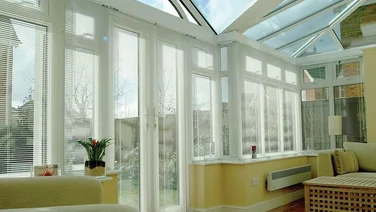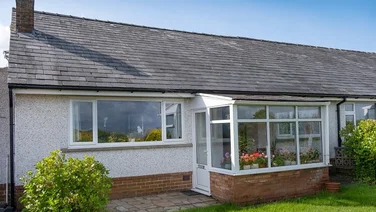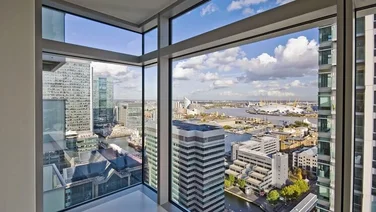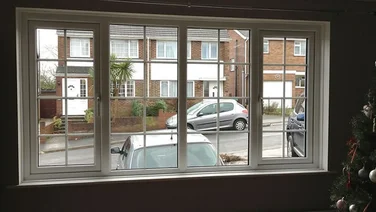- Is double glazing allowed on listed buildings?
- What are heritage homes?
- Benefits of adding double glazing to a heritage home
- What is ‘heritage double glazing’?
- Price of heritage double glazing
- Does double glazing on a listed building cost more?
- What are the downsides of installing double glazing on a listed building?
- Do I need planning permission to install double glazing on a heritage home?
- Things to consider before installing double glazing on your listed building
- Next steps
- Summary
- Rising energy costs make insulation more important than ever, but listed buildings have unique challenges regarding double glazing.
- If you own a heritage home, you may face planning restrictions that limit your options for upgrading your windows.
- Listed building approved (i.e, allowed by UK building regulations) secondary glazing can improve insulation while preserving your home’s historic character.

Energy bills are soaring, making insulating your home more important than ever. Double glazing costs a lot, but it’s one of the most effective and popular energy-saving methods available.
Getting double glazing for your home isn’t a standard process, though, as different rules apply to different property types. This is especially true if you are lucky enough to live in a listed building, sometimes called a ‘heritage home’.
Many homes in the United Kingdom are more than 50 years old now, with many more than 100 years old or older. And these old properties can benefit significantly from double glazing. For listed or ‘heritage homes’, there are often planning restrictions in place that limit your options. Still, so long as the planned installation is sensitive to these, such homes can significantly benefit.
We’ve looked into whether you can install double glazing on a listed building/heritage home, how you can apply for planning permission and what impact it could have on your home’s value.
Once you’re ready to move forward with a quote, you can fill in our simple form here and we’ll put you in touch with our trusted suppliers. They’ll get back to you with bespoke double glazing quotes for you to compare.
What type of double glazing do you need?
Get startedIs double glazing allowed on listed buildings?
You can install double glazing on a listed building, but it is not as simple as in other properties. That’s because listed buildings are protected for their historical significance, beauty or both.
Double glazing often costs more for listed buildings because they typically have timber or stone window frames, making installing modern uPVC double glazing impossible. Planning authorities, such as English Heritage, will seek to stop changes to a listed building’s key features, including most forms of double glazing.
This is a problem for homeowners living in a listed building because the windows are often thin and poor at keeping warmth inside. Their level of sound insulation is often bad, too.
Even if you choose double glazing with a wood-finish frame, heritage groups will likely look to block planning permission. There are options, though, such as secondary glazing. This is where a second pane of glass is installed behind an existing window without any need to replace or alter the frames.
And when it comes to replacing it, you can remove the secondary glazing discreetly, as it’s typically not attached to a frame.
The same rules for double glazing apply to Grade I listed buildings: no uPVC double glazing, no other modern window types and nothing that impacts the property’s window frames. Grade I listed buildings are even rarer than Grade II – around 12,500 exist in the UK – meaning you must carefully consider any alterations.
Historic England makes it clear that secondary glazing is the most acceptable option, explaining: “Secondary glazing, when carefully designed and installed, allows the original windows to be retained unaltered and repaired where necessary, while reducing air leakage and conducted heat losses.”
“As a result, there is no loss of historic fabric and, in most cases, the installation is easily reversible,” it adds.
What are heritage homes?
A heritage home is a property that holds significant architectural, cultural or aesthetic value, often due to its age, unique design or historical importance. These homes contribute to the historic fabric of an area and may be protected by planning regulations to preserve their character.
In many cases, heritage homes are listed properties, meaning they are legally recognised for their historical and architectural significance, and any modifications require special permissions. Owning a heritage home often involves restrictions to ensure that renovations and restorations maintain the property’s original character.
Several factors determine whether a home is classified as a heritage property:
- Age – Homes over a certain age (eg, 100 years or more) are considered heritage.
- Architectural style – Distinctive design features from a particular era or movement (eg, Georgian, Victorian or Art Deco).
- Historical significance – Connections to important historical events, figures or societal developments.
- Cultural value – A property that reflects the traditions or identity of a community.
- Listed status – Officially designated by a governing body for protection under heritage conservation laws.
Certain features, such as heritage windows, (more on these later) are carefully regulated within heritage homes. These are replacement windows designed to match the original style and materials of the property while meeting modern efficiency standards.
Because ‘heritage’ and ‘listed’ usually overlap, owning such a home means adhering to strict conservation guidelines, particularly when upgrading or replacing structural elements such as windows, doors and façades.

Benefits of adding double glazing to a heritage home
If you live in a heritage home, your EPC rating is likely lower due to older construction methods, single-glazed windows and less-efficient insulation. However, it should be noted that most listed buildings are exempt from requiring an official EPC, though they can be created voluntarily.
Many listed properties can feel draughty and noisy, and be expensive to heat, making them less comfortable in winter and prone to condensation and dampness.
Heritage-approved double glazing offers a practical solution, helping you save on energy bills, improve your home’s comfort and increase its market value. While traditional double glazing may not always be permitted in listed buildings, specially designed heritage or secondary glazing can provide modern efficiency without compromising the historic character of your home.
Installing double glazing offers pretty much the same benefits to listed and heritage buildings as it does to any other:
- Improve energy efficiency by up to 30% – By reducing heat loss through windows, heritage double glazing can significantly lower your heating bills.
- Reduce condensation and mould – Maintaining a more stable indoor temperature reduces condensation build-up, helping prevent damp and mould issues.
- Cut carbon emissions – A more energy-efficient home means a smaller carbon footprint, aligning with modern sustainability goals.
- Maintain the building’s aesthetic character – Heritage-approved glazing solutions replicate the original style, ensuring your home retains its historic charm.
- Enhance acoustic insulation – Older homes can let in excessive noise from outside, but heritage double glazing helps create a quieter indoor environment.
- Increase property value – Double glazing is a sought-after feature for buyers. Research suggests it can increase the value of the average UK home by 10%, making it a worthwhile investment.
If planning restrictions allow, choosing, for example, Georgian-style windows or another design matching the era of your home ensures that your property’s appearance remains unchanged while benefiting from modern insulation.
Heritage or secondary glazing is a smart way to combine historic preservation with contemporary comfort, making your listed building more enjoyable to live in while enhancing its value.
What type of double glazing do you need?
Get startedWhat is ‘heritage double glazing’?
Heritage double glazing is a specialist double glazing that tends to be ultra-slim, low-profile double glazing with an overall thickness of 6-11mm. Regular double glazing tends to be between 12 and 28mm thick.
The gap between panes of glass is typically filled with either inert krypton gas or can be vacuum-sealed. Traditional double glazing, on the other hand, tends to be filled with air or argon gas.
Heritage double glazing is less energy efficient than conventional double glazing but more efficient than single glazing. It can be retrofitted into existing window frames if they are in good enough condition.
Price of heritage double glazing
Given the nature of listed buildings and heritage homes, most window retrofit projects are priced ad hoc. This is because most projects require the replacement windows to match the aesthetics of the original windows as much as possible.
This could mean that replacement windows need to be made to order rather than sourcing and installing pre-made units, like regular double glazing. Due to limitations on what you can do to protect buildings of this nature, you may be required to source and install more expensive windows, typically timber frames, but metal (aluminium) could be an option.
In all cases, you are advised to seek professional help before considering what double glazing units to install.
Does double glazing on a listed building cost more?
Yes, double glazing in listed buildings costs more because the windows are more expensive to make. Owners usually choose slim-profile double glazing, as it fits better with traditional window styles.
This makes secondary glazing a cheaper alternative for listed-building owners. Not only does secondary glazing cost less but, in some cases, it’s better at insulating than ordinary double glazing.
However, if approved for Listed Building Consent, standard double glazing can be easily used in extensions or conversions. Extensions are typically built using modern materials, so getting the most efficient glazing makes sense.
What are the downsides of installing double glazing on a listed building?
You’ll save on your energy bills and keep your home warmer with double glazing, but there are some downsides. Here are the main cons of installing double glazing on a listed building:
- Preserving historical authenticity – Listed buildings have unique architectural features that can be difficult to replicate with modern double glazing.
- Conservation regulations and planning permission challenges – Strict rules protect historic properties, requiring special permission for alterations, and obtaining approval can be complex and time-consuming, especially if the proposed glazing significantly changes the building’s exterior.
- Changes to the building’s aesthetic – Standard double glazing can look out of place, and heritage-approved glazing must closely match the original design.
- Potential damage to historic materials – Older materials such as timber and stone can be delicate. Double glazing could weaken or damage the original structure if not installed carefully.
- Increased condensation risks – While double glazing improves insulation, it can sometimes lead to excess condensation in older buildings. This moisture build-up can cause wooden frames to rot and contribute to mould or mildew on stone walls.
- Slim-profile glazing concerns – In listed buildings, slim-profile double glazing is often preferred over standard glazing. However, it is more prone to misting and condensation, reducing visibility and effectiveness over time.
Do I need planning permission to install double glazing on a heritage home?
In most cases, yes, you need planning permission to install double glazing on listed buildings and heritage homes. Planning permission for historic buildings is called Listed Building Consent, and you must apply for it before making any alterations, including secondary glazing.
Failure to do so is a criminal offence.
You will need to apply for planning permission if:
- You’re replacing the windows with a new style of window
- There is a change to the materials used for the frames
- There is a change in the type of glazing, eg, single glazing to double glazing
- You’re painting existing windows a different colour
- You’re proposing to re-glaze, involving the loss of original glass
Here’s how to apply for Listed Building Consent:
- Contact your Local Planning Authority — each council website will have a section dedicated to planning, where you can fill in your property details and will be put in touch with a conservation officer, or you can download an application form to fill in.
- Discuss your options — your conservation officer will assess the property’s listed status, what the current window situation is and what you’ll likely be allowed to do.
- Wait for confirmation — the planning authority will look into the desirability of protecting your property, its setting and the features that make it special. The risk of damage is too high in some cases, so prepare for rejection
If you succeed in your application, you’ll be granted planning permission and told what window modifications you can make.
Things to consider before installing double glazing on your listed building
Installing double glazing on a listed building or heritage home requires careful planning to ensure compliance with regulations while preserving the property’s historic character. Here are the key factors to consider:
- Check if you need planning permission – In most cases, listed building consent is required for double glazing. Secondary glazing is often easier to get approved than full window replacements.
- Find frames that match the building’s aesthetics – Your new windows should replicate the original design as closely as possible. Heritage groups typically reject wood-effect or imitation frames (though not always acceptable by local authorities), so you may need to use real timber or a near-invisible alternative.
- Consider the type of glass used – Modern glass is too flat and can look out of place compared to older, naturally imperfect glass. Some heritage glazing companies offer an anti-glare or subtly flawed glass to blend in better.
- Budget for higher costs – Heritage double glazing is more expensive than standard double glazing due to the need for custom materials and compliance with conservation regulations. Expect higher costs for bespoke solutions.
- Factor in installation challenges – Older buildings often have non-standard window sizes and fragile materials, making installation more complex and costly.
- Assess the condition of existing windows – If your original windows are severely damaged, you may need restoration work before installing any double glazing or secondary glazing.
- Weigh energy efficiency benefits against costs – Double glazing can reduce heat loss by up to 30%. However, secondary glazing is often the more viable option for listed buildings while providing insulation benefits.
- Understand long-term maintenance needs – Heritage-approved glazing often requires specialist maintenance to prevent damage to the original structure.
- Check for alternative solutions – If full double glazing isn’t possible, secondary glazing, draught-proofing, and shutters can improve insulation while keeping the original windows intact.
Next steps
Before installing double glazing in a listed building or heritage home, checking whether you need planning permission is crucial. Here’s how to find out:
- Check your home’s listed status – If your property is Grade I, II* or II listed (England & Wales), Category A, B or C (Scotland), or Grade A to B2 in Northern Ireland, you will likely need permission.
- Look at local conservation area rules – Even if your home isn’t listed, strict regulations may apply if you live in a designated conservation area.
- Contact your local planning authority (LPA) – Your council’s planning office can confirm whether permission is required.
- Check Historic England, Historic Environment Scotland, Cadw (Wales) and Nidirect (Northern Ireland) – These organisations provide official guidance on alterations to listed properties.
- Consult your property’s listing description – Some homes have specific window and external feature restrictions.
- Speak to a heritage specialist – Professionals experienced in listed buildings can advise on the best glazing options while ensuring compliance.
- Use our online form – Get a free, no-obligation quote by filling out our quick form.
Summary
- Double glazing can make your heritage home warmer, quieter and more energy-efficient, but planning restrictions mean it’s not always straightforward.
- If you live in a listed building, checking planning rules before making any changes is essential to avoid costly mistakes.
- Heritage-approved or secondary glazing offers a great way to improve insulation while maintaining your home’s historic charm.
- While double glazing can increase property value, choosing solutions that comply with conservation regulations is important.
- Specialist suppliers can help you find the right glazing that balances energy efficiency, aesthetics and planning requirements.
- That makes finding a balance between the two important, but thankfully double or secondary glazing can often be installed without damaging a property.
- If you’d like to find quotes for double glazing, why not fill in our simple form? All you need to do is enter a few details and we’ll pass them to our trusted suppliers. They’ll get back to you with double glazing quotes for you to compare.






